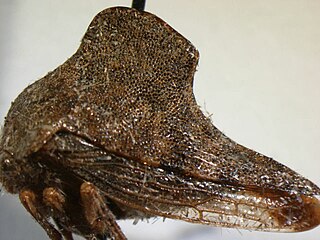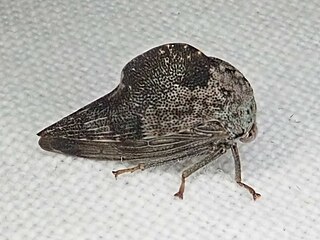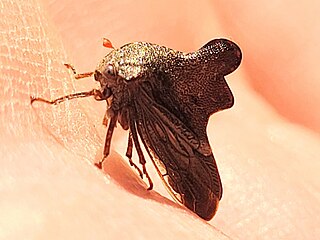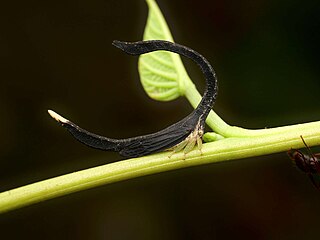
Treehoppers and thorn bugs are members of the family Membracidae, a group of insects related to the cicadas and the leafhoppers. About 3,200 species of treehoppers in over 400 genera are known. They are found on all continents except Antarctica; only five species are known from Europe. Individual treehoppers usually live for only a few months.
Hygia is a large genus of Asian seed bugs in the tribe Colpurini, erected by Philip Reese Uhler in 1861.

Enchenopa binotata is a complex of multiple species found mostly in Eastern North America, but have also been reported in Central America. They are commonly referred to as treehoppers and are sap-feeding insects. The species in the complex look similar to each other in morphology, but are identified as different species by the host plant they occupy.

Microcentrus caryae, the hickory stegaspidine treehopper, is a species of treehopper in the family Membracidae.
Amulius is a genus of Asian bugs in the family Reduviidae. It has been placed in the tribe Ectinoderini: the 'Oriental resin bugs'.
The Colpurini are a tribe of leaf-footed bugs, in the subfamily Coreinae erected by Gustav Breddin in 1900. Genera are distributed from India, South-East Asia through to Australia and New Zealand. The tribe name (type) is based on Colpura Bergroth: now a subgenus of Hygia.

Lyramorpha is a genus of stink bugs in the family Tessaratomidae, subfamily Oncomerinae. It is known from Australia and New Guinea.
Pygoda civilis is a species of stink bug in the family Pentatomidae found in Ecuador. It was first described as Edessa civilis by Gustav Breddin in 1903 and renamed under genus Pygoda in 2018.

Telamona agrandata is a species of treehopper in the genus Telamona.

Telamona projecta is a species of treehopper in the family Membracidae.
Telamona monticola is a species of treehopper in the family Membracidae. It is commonly found on oak trees. Nymphal development occurs in eight weeks.

Telamona reclivata is a species of treehopper in the family Membracidae.
Trachytalis isabellina is a species of treehopper in the family Membracidae.
Trachytalis distinguenda is a species of treehopper in the family Membracidae.

Heliria praealta is a species of treehopper in the family Membracidae. It is found in the western United States and Canada.

Cladonota is a genus of neotropical treehoppers widespread from Mexico to South America. They are known for their elaborate pronotum shapes, hypothesized to play a role in camouflage or mate recognition, although their function is not yet known with certainty. Previously described as a subgenus of Sphongophorus, it was recognized as a genus of its own right in 1997 after the latter was synonymized with Hypsauchenia.

Membracis mexicana is a species of treehopper within the family Membracidae. The species can be found distributed from California to Colombia and Ecuador. The coloration of adults is black with yellow markings on the body, whereas nymphs start out black before eventually becoming white with 3 black dots and a reddish belt separating thorax and abdomen. Adults are considered minor pests in crops such as Avocados.

Cladonota apicalis is a species of treehopper within the family Membracidae. The species is found distributed in Mexico, Central America, Ecuador, Bolivia, Peru, Venezuela, and Brazil. Individuals typically reach lengths of 6 to 9 millimeters. The species name was likely given after the white mark on the dorsal posterior surface.

Heteronotus nodosus is a species of treehopper within the family Membracidae. The species is known to be found distributed in Brazil, Costa Rica, and Peru, where individuals are found exclussively feeding on Calliandra angustifolia. The species name nodosus means 'full of knots' in latin. Ants in the genera Pheidole and Crematogaster have been observed attending Peruvian treehoppers for their honeydew secretions, however for H. nodosus, the adults repel any ants attending the immatures by vigorously moving the abdomen.











